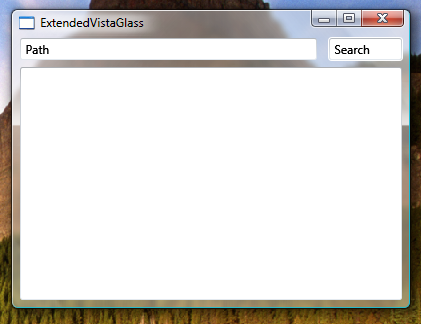Étendre le cadre de transparence dans une application WPF
Cette rubrique montre comment étendre le cadre de verre Windows Vista dans la zone cliente d’une application WPF (Windows Presentation Foundation).
Remarque
Cet exemple fonctionne uniquement sur un ordinateur Windows Vista exécutant le Gestionnaire de fenêtres de bureau (DWM) avec une fenêtre activée. Windows Vista Home Basic édition ne prend pas en charge l’effet de verre transparent. Les zones qui seraient généralement rendues avec l’effet de verre transparent sur d’autres éditions de Windows Vista sont rendues opaques.
Cadre en verre étendu dans une barre d’adresse
L’image suivante illustre le cadre en verre étendu dans la barre d’adresse d’Internet Explorer 7 :

Pour étendre le cadre en verre sur une application WPF, l’accès à l’API non managée est nécessaire. L’exemple de code suivant effectue un appel de plateforme (pinvoke) pour les deux API nécessaires pour étendre la trame dans la zone cliente. Chacune de ces API est déclarée dans une classe appelée NonClientRegionAPI.
[StructLayout(LayoutKind.Sequential)]
public struct MARGINS
{
public int cxLeftWidth; // width of left border that retains its size
public int cxRightWidth; // width of right border that retains its size
public int cyTopHeight; // height of top border that retains its size
public int cyBottomHeight; // height of bottom border that retains its size
};
[DllImport("DwmApi.dll")]
public static extern int DwmExtendFrameIntoClientArea(
IntPtr hwnd,
ref MARGINS pMarInset);
<StructLayout(LayoutKind.Sequential)>
Public Structure MARGINS
Public cxLeftWidth As Integer ' width of left border that retains its size
Public cxRightWidth As Integer ' width of right border that retains its size
Public cyTopHeight As Integer ' height of top border that retains its size
Public cyBottomHeight As Integer ' height of bottom border that retains its size
End Structure
<DllImport("DwmApi.dll")>
Public Shared Function DwmExtendFrameIntoClientArea(ByVal hwnd As IntPtr, ByRef pMarInset As MARGINS) As Integer
End Function
DwmExtendFrameIntoClientArea est la fonction DWM qui étend le cadre dans la zone cliente. Elle nécessite deux paramètres ; un handle de fenêtre et une structure MARGINS. MARGINS indique à DWM le niveau d’extension du cadre dans la zone cliente.
Cadre en verre étendu sur l’événement Loaded
Pour utiliser la fonction DwmExtendFrameIntoClientArea, un handle de fenêtre doit être obtenu. Dans WPF, le handle de fenêtre peut être obtenu à partir de la Handle propriété d’un HwndSource. Dans l’exemple suivant, le frame est étendu dans la zone cliente sur l’événement Loaded de la fenêtre.
void OnLoaded(object sender, RoutedEventArgs e)
{
try
{
// Obtain the window handle for WPF application
IntPtr mainWindowPtr = new WindowInteropHelper(this).Handle;
HwndSource mainWindowSrc = HwndSource.FromHwnd(mainWindowPtr);
mainWindowSrc.CompositionTarget.BackgroundColor = Color.FromArgb(0, 0, 0, 0);
// Get System Dpi
System.Drawing.Graphics desktop = System.Drawing.Graphics.FromHwnd(mainWindowPtr);
float DesktopDpiX = desktop.DpiX;
float DesktopDpiY = desktop.DpiY;
// Set Margins
NonClientRegionAPI.MARGINS margins = new NonClientRegionAPI.MARGINS();
// Extend glass frame into client area
// Note that the default desktop Dpi is 96dpi. The margins are
// adjusted for the system Dpi.
margins.cxLeftWidth = Convert.ToInt32(5 * (DesktopDpiX / 96));
margins.cxRightWidth = Convert.ToInt32(5 * (DesktopDpiX / 96));
margins.cyTopHeight = Convert.ToInt32(((int)topBar.ActualHeight + 5) * (DesktopDpiX / 96));
margins.cyBottomHeight = Convert.ToInt32(5 * (DesktopDpiX / 96));
int hr = NonClientRegionAPI.DwmExtendFrameIntoClientArea(mainWindowSrc.Handle, ref margins);
//
if (hr < 0)
{
//DwmExtendFrameIntoClientArea Failed
}
}
// If not Vista, paint background white.
catch (DllNotFoundException)
{
Application.Current.MainWindow.Background = Brushes.White;
}
}
Cadre de verre étendu dans la zone cliente
L’exemple suivant montre une simple fenêtre dans laquelle le cadre est étendu dans la zone cliente. Le cadre est étendu derrière la bordure supérieure qui contient les deux TextBox objets.
<Window x:Class="SDKSample.Window1"
xmlns="http://schemas.microsoft.com/winfx/2006/xaml/presentation"
xmlns:x="http://schemas.microsoft.com/winfx/2006/xaml"
Title="Extended Glass in WPF" Height="300" Width="400"
Loaded="OnLoaded" Background="Transparent"
>
<Grid ShowGridLines="True">
<DockPanel Name="mainDock">
<!-- The border is used to compute the rendered height with margins.
topBar contents will be displayed on the extended glass frame.-->
<Border Name="topBar" DockPanel.Dock="Top" >
<Grid Name="grid">
<Grid.ColumnDefinitions>
<ColumnDefinition MinWidth="100" Width="*"/>
<ColumnDefinition Width="Auto"/>
</Grid.ColumnDefinitions>
<TextBox Grid.Column="0" MinWidth="100" Margin="0,0,10,5">Path</TextBox>
<TextBox Grid.Column="1" MinWidth="75" Margin="0,0,0,5">Search</TextBox>
</Grid>
</Border>
<Grid DockPanel.Dock="Top" >
<Grid.ColumnDefinitions>
<ColumnDefinition/>
</Grid.ColumnDefinitions>
<TextBox Grid.Column="0" AcceptsReturn="True"/>
</Grid>
</DockPanel>
</Grid>
</Window>
L’image suivante illustre le cadre en verre étendu dans une application WPF :

Voir aussi
.NET Desktop feedback
